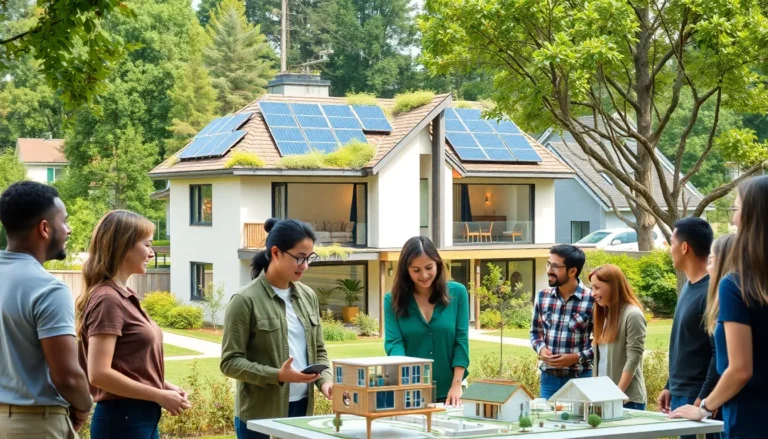Table of Contents
ToggleImagine a world where your coffee brews itself, your lights dance to your favorite tunes, and your thermostat knows exactly when you’re feeling chilly. Welcome to the age of smart home technology, where convenience and innovation collide in the most delightful way. Gone are the days of fumbling for light switches or arguing with your thermostat—now, your home can be as clever as your smartphone.
Overview Of Smart Home Technology
Smart home technology integrates devices and systems for improved home automation. It encompasses a range of products such as smart thermostats, lighting systems, security cameras, and voice assistants. Homeowners can control these devices remotely through smartphones or voice commands.
Energy efficiency stands out among the benefits of smart home technology. Smart thermostats, like the Nest or Ecobee, learn user preferences and adjust temperatures accordingly, reducing energy consumption by up to 15%. Smart lighting systems, such as Philips Hue, allow users to schedule lighting and choose colors to maximize efficiency.
Security has also evolved with smart technology. Devices like Ring doorbells and Arlo cameras provide real-time monitoring and alerts to homeowners. Intruders are deterred by the presence of visible cameras and the ability to check footage via a mobile app.
Voice assistants like Amazon Alexa and Google Assistant serve as central hubs for smart homes. These systems facilitate integration with various devices, allowing users to control multiple aspects of their home with simple voice commands.
Market trends indicate that smart home technology is gaining traction; in 2022, the global smart home market was valued at approximately $91 billion. Projections expect it to reach $158 billion by 2024, driven by growing consumer demand for convenience and security.
Interconnectivity enhances the user experience. Devices often work together seamlessly, for instance, when a motion detector signals outdoor lights to turn on when someone approaches. Integration contributes to a more cohesive and efficient domestic environment.
Benefits Of Smart Home Technology

Smart home technology offers numerous advantages, enhancing the overall living experience. From improved security to energy efficiency, these innovations make daily routines more manageable.
Enhanced Security
Security evolves with smart home technology. Smart devices like Ring doorbells and Arlo cameras provide real-time monitoring and alerts. Homeowners receive notifications on their smartphones, ensuring immediate awareness of any activity. Visible cameras deter potential intruders, contributing to a safer environment. In fact, studies show that homes with security cameras face less than a 10% chance of being targeted. Integration with voice assistants enhances security measures further, as users can issue commands to monitor or lock doors.
Energy Efficiency
Energy efficiency stands out as a vital benefit. Smart thermostats like Nest and Ecobee automatically adjust settings based on user preferences. They reduce energy consumption by up to 15%, leading to significant cost savings. Smart lighting systems, such as Philips Hue, offer scheduling features that align with daily activities, ensuring lights operate only when necessary. Together, these technologies help minimize waste while maximizing comfort. Utilities often provide incentives for adopting smart home solutions, further encouraging energy-efficient practices.
Convenience And Comfort
Convenience and comfort improve significantly with smart technology. Homeowners can manage tasks like brewing coffee or adjusting blinds from their smartphones or through voice commands. Routine activities become effortless, allowing more time for leisure. Smart home devices can communicate with each other, creating an integrated environment that adapts to individual lifestyles. Studies indicate that users perceive a 30% decrease in daily task completion time thanks to automation. Enhanced customization options ensure that every home tailored to specific preferences brings a greater sense of comfort.
Popular Smart Home Devices
Smart home devices simplify daily routines and improve efficiency. Key categories include smart speakers, smart thermostats, and smart lighting systems.
Smart Speakers
Smart speakers integrate voice recognition and smart home control. Devices such as Amazon Echo and Google Nest Hub enable users to manage home systems with voice commands. Music streaming and information access become seamless with these devices. Enhanced functionalities, like controlling lights and thermostats, elevate user experience. Compatibility with various smart home devices allows for centralized control, making everyday tasks effortless.
Smart Thermostats
Smart thermostats transform energy management in homes. Products like Nest and Ecobee learn user habits, adjusting temperatures based on preferences. Users can optimize energy consumption by reducing heating or cooling when no one is home. Data analytics provide insights into usage patterns, resulting in savings of up to 15% on energy bills. Remote access via smartphone apps enables greater control over home comfort.
Smart Lighting
Smart lighting systems provide flexible control over home ambiance. Options like Philips Hue allow users to schedule lighting based on daily routines. Color and brightness adjustments enhance moods or set specific atmospheres for different occasions. Energy-efficient LED technology minimizes consumption while maximizing brightness. Integration with voice assistants offers hands-free control, making lighting adjustments quick and easy.
Challenges And Considerations
Smart home technology presents various challenges that homeowners should consider. Among these challenges are privacy concerns and compatibility issues.
Privacy Concerns
Personal data security poses significant risks with smart devices. Users often share sensitive information with devices, leaving them vulnerable to hacking. For instance, smart cameras and voice assistants collect audio and visual data, creating potential privacy breaches. Consumer trust departs when data handling isn’t transparent or secure. It’s important for manufacturers to provide clear privacy policies and protection measures. Ensuring devices have robust encryption protocols can mitigate these risks effectively. Implementing user-controlled privacy settings also fosters greater security awareness and accountability.
Compatibility Issues
Compatibility among devices frequently complicates smart home integration. Numerous brands and ecosystems exist, creating potential barriers to seamless operation. Homeowners may encounter difficulties connecting products from different manufacturers. Lack of standardization leads to fragmented user experiences, causing frustration. Smart hubs facilitate many connections, yet not all devices may be compatible with each other. Users should research compatibility before investing in smart devices. Familiarity with ecosystems, such as Google Home or Amazon Alexa, can enhance overall functionality and reduce integration issues.
The Future Of Smart Home Technology
Advancements in smart home technology promise greater integration and efficiency. Devices will increasingly communicate with each other, creating a seamless experience for users. Homeowners can expect smart home systems to personalize settings based on individual preferences. Leveraging artificial intelligence, devices will adapt to daily routines and improve over time.
Robust market growth underscores this shift. The global smart home technology market, valued at around $91 billion in 2022, is forecasted to reach $158 billion by 2024. This surge reflects consumer demand for enhanced convenience and security features. Companies known for security innovation, such as Ring and Arlo, continuously elevate their offerings to meet these needs.
Sustainability will play a significant role in the future landscape. Smart energy solutions will not only optimize consumption but will also appeal to eco-conscious consumers. For instance, smart thermostats can contribute to a potential 15% reduction in energy costs, promoting responsible usage.
Users can anticipate improved compatibility among devices. Emerging technologies will reduce integration issues, allowing products from different brands to work together. Homeowners find value in ecosystems like Google Home and Amazon Alexa, which will increasingly support diverse devices and applications.
Privacy concerns remain paramount. Users expect manufacturers to prioritize data security with enhanced encryption and clear privacy policies. Balancing innovation with user trust will shape the direction of smart home technology moving forward. These considerations will influence purchasing decisions, driving companies toward transparency and robust security measures as they evolve solutions to meet demand.
Smart home technology is transforming the way people live by offering unparalleled convenience and efficiency. As devices become more interconnected homeowners can enjoy a seamless experience that enhances their daily routines. With advancements in artificial intelligence and energy-efficient solutions the future looks promising for smart home integration.
However it’s essential for users to remain vigilant about privacy and compatibility issues. By staying informed and choosing the right products homeowners can maximize the benefits of smart technology while minimizing potential risks. As this market continues to grow the emphasis on security and user-friendly integration will shape the landscape of smart homes for years to come. Embracing these innovations not only leads to a more comfortable lifestyle but also contributes to a sustainable future.




